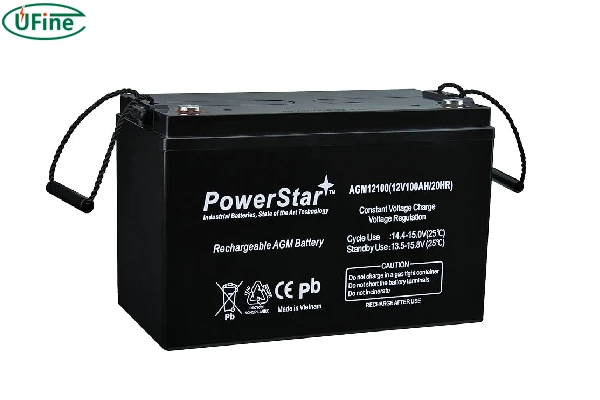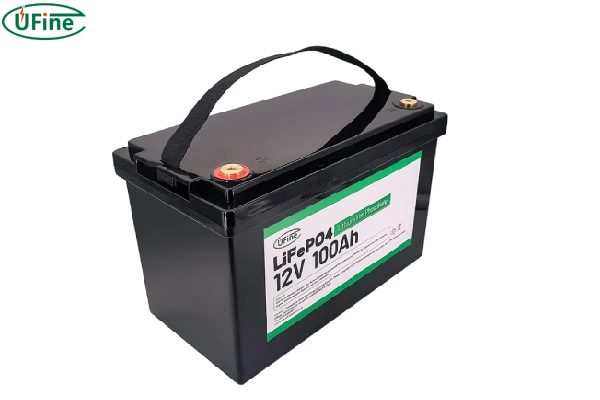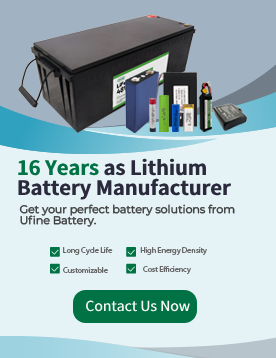
Part 1. What is a Group 27 battery?
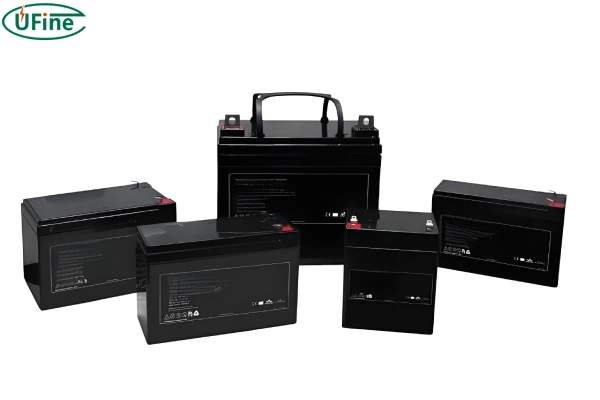
Group 27 batteries typically measure around 12.1 inches in length, 6.8 inches in width, and 8.9 inches in height. This standardized size allows them to fit into various battery compartments and enclosures, making them a convenient option for many applications.
Why “Group 27”?
The “Group 27” designation for a battery refers to a standardized battery size as defined by the Battery Council International (BCI). This group size classification helps consumers and manufacturers identify batteries with specific dimensions and characteristics to ensure compatibility with various applications.
Here’s a breakdown of what the Group 27 designation means:
Group Size Explanation
The BCI has created a set of standards for automotive and industrial batteries, where each group size corresponds to specific dimensions and characteristics.
These standards help ensure that batteries will fit properly in the battery compartment of vehicles and other equipment.
Physical Dimensions:
Group 27 batteries have specific dimensions: approximately 12.1 inches (306 mm) in length, 6.8 inches (173 mm) in width, and 8.9 inches (226 mm) in height.
While the exact dimensions can vary slightly between manufacturers, they adhere closely to these standards to maintain compatibility.
So, the “Group 27” designation is a standardized size classification that provides a reference for the physical dimensions and typical applications of the battery. This Standardization ensures that consumers and manufacturers can easily identify and replace batteries across different devices and vehicles.
Part 2. Group 27 battery parameters
When choosing a Group 27 battery, consider the following parameters to ensure you select the right battery for your application:
1. Group 27 battery size
Group 27 batteries typically measure approximately 12.1 inches in length, 6.8 inches in width, and 8.9 inches in height. This standardized size allows them to fit into various battery compartments and enclosures, making them a versatile option for many applications.
2. Weight
The weight of Group 27 batteries can vary depending on the type. Flooded lead-acid batteries are the heaviest, usually weighing between 50 to 60 pounds. AGM and Gel batteries are slightly lighter, typically weighing around 45 to 55 pounds. Lithium-Ion batteries are the lightest, often weighing between 25 to 30 pounds. The lighter weight of Lithium-Ion batteries makes them easier to handle and install, especially in applications where weight is a critical factor.
3. Voltage
Most Group 27 batteries operate at a standard voltage of 12 volts. This voltage is suitable for powering a wide range of devices and systems, from marine electronics to RV appliances. The consistent voltage output ensures reliable performance in various applications.
4. Capacity
Capacity is measured in ampere-hours (Ah) and indicates how much energy the battery can store. Group 27 batteries typically have a capacity ranging from 85Ah to 105Ah. Higher capacity batteries provide longer run times, which is essential for applications requiring extended use. For instance, a higher capacity battery would be beneficial for powering an RV’s electrical system overnight or running a boat’s trolling motor for extended periods.
5. Price
The price of Group 27 batteries varies based on the type and brand. Flooded lead-acid batteries are generally the most affordable, making them an attractive option for budget-conscious buyers. AGM and Gel batteries are more expensive due to their advanced technology and maintenance-free design. Lithium-Ion batteries are the most expensive but offer the best performance and longest lifespan, providing better long-term value.
Part 3. Group 27 battery types
Group 27 batteries come in several types, each with unique characteristics and benefits. Understanding these differences can help you choose the best battery for your needs.
1. Group 27 Flooded Lead-Acid Batteries
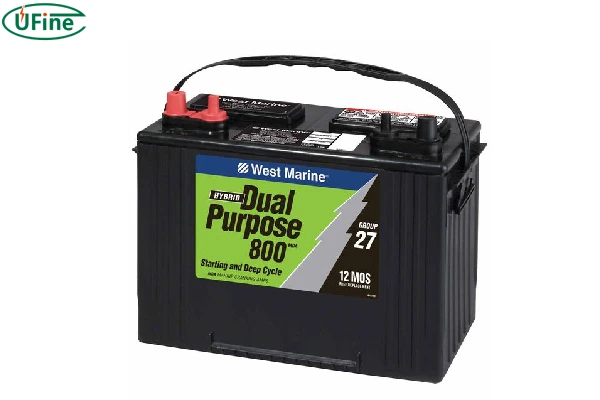
Flooded lead-acid batteries are the most traditional type of Group 27 battery. They contain liquid electrolytes and require regular maintenance, such as checking and topping off the water levels. These batteries are robust and cost-effective, making them suitable for high-demand applications. However, they must be kept upright to prevent spills and leaks.
2. Group 27 Sealed Lead-Acid (SLA) Batteries
Sealed Lead-Acid batteries, including Absorbent Glass Mat (AGM) and Gel batteries, are maintenance-free and can be installed in any position. AGM batteries use a fiberglass mat to absorb the electrolyte, making them spill-proof and more resistant to vibrations. Gel batteries use a silica gel to immobilize the electrolyte, providing deep discharge capabilities and a longer lifespan. These batteries are safer and require less maintenance than flooded lead-acid batteries.
3. Group 27 Lithium-Ion Batteries
Lithium-Ion batteries are the most advanced type of Group 27 battery. They offer high energy density, are lightweight, and have a long lifespan. Lithium-Ion batteries require no maintenance and have a high discharge rate, making them ideal for applications where weight and efficiency are crucial. They are also more environmentally friendly, not containing harmful lead or acid.
Part 4. How to choose a Group 27 battery Ah?
When selecting a Group 27 battery, one of the most important factors is ampere-hour (Ah) capacity, which indicates how much energy the battery can store and deliver over time.
Typical Group 27 batteries have capacities ranging from 85Ah to 110Ah, depending on the chemistry (AGM, lithium, etc.). Here’s how to choose:
- For RVs and marine use: Choose a battery with 100Ah or more if you plan to run appliances, lights, or electronics for extended periods.
- For trolling motors: Look for at least 90Ah, especially if used all day.
- For backup or solar storage: Higher Ah (100–110Ah) is better to maximize autonomy between charges.
- For starting batteries: Cranking amps (CA/CCA) may matter more than Ah, but a higher Ah can provide longer reserve capacity.
Tip: Match your battery Ah to your daily power consumption. Use watt-hour (Wh) calculations to estimate energy usage and convert to Ah (Wh ÷ Voltage = Ah).
Part 5. What is a Group 27 deep cycle battery?
A Group 27 deep cycle battery is designed to provide a steady amount of power over a long period and withstand repeated charging and discharging cycles. Unlike starting batteries, which deliver short bursts of high current, deep cycle batteries are built for long-duration power delivery.
Key characteristics of Group 27 deep cycle batteries:
Discharge depth tolerance: Can be discharged up to 80% (though 50% is ideal for long life)
Applications: Perfect for RVs, marine trolling motors, solar energy storage, off-grid systems, and backup power
Construction: Often comes in AGM (Absorbent Glass Mat) or Lithium (LiFePO4) formats
Durability: Typically lasts 3–10 years, depending on chemistry and usage
These batteries are ideal for users who require consistent, reliable power over extended periods, especially when access to charging is limited.
Part 6. Group 27 battery – Lithium vs. AGM
Choosing between lithium (LiFePO4) and AGM for a Group 27 battery depends on your priorities for performance, weight, cost, and cycle life.
| Feature | Lithium (LiFePO4) | AGM (Absorbent Glass Mat) |
|---|---|---|
| Weight | ~50–70% lighter | Heavier |
| Cycle Life | 2000–5000 cycles | 300–600 cycles |
| Usable Capacity | ~100% of rated Ah | ~50–60% of rated Ah |
| Charging Speed | Fast | Slower |
| Maintenance | None | None |
| Cold Performance | Weaker below 0°C (needs heating) | Better cold-weather performance |
| Cost | Higher upfront | Lower upfront |
Choose lithium if you prioritize weight savings, longevity, and fast charging, and are willing to invest more upfront.
Choose AGM if you need a reliable, budget-friendly battery that works well in colder environments and don’t need high cycle life.
Tip: For solar storage or off-grid setups, lithium provides better long-term value despite its higher cost, while AGM works well for seasonal or backup use.
Part 7. How to charge group 27 battery?
Properly charging your Group 27 battery is crucial to maintaining its performance and longevity. Here are the steps to charge a Group 27 battery:
- Choose the Right Charger: Ensure you use a charger compatible with your battery type. AGM and Gel batteries require a different charging profile than flooded lead-acid batteries. Lithium-Ion batteries need a smart charger with a built-in battery management system (BMS) to ensure safe and efficient charging.
- Connect the Charger: Attach the charger clamps to the battery terminals, with the red clamp connecting to the positive (+) terminal and the black clamp to the negative (-) terminal. Make sure the connections are secure and clean.
- Set the Charger: Select the appropriate charging mode for your battery type. For example, AGM and Gel batteries might require a slower charging rate compared to flooded batteries. Refer to the battery manufacturer’s instructions for the recommended charging settings.
- Monitor the Charging Process: Keep an eye on the charging progress. Avoid overcharging, as it can damage the battery. Smart chargers often have indicators or automatic shut-off features to prevent overcharging. If using a manual charger, monitor the battery voltage and disconnect the charger when the battery is fully charged.
- Disconnect the Charger: Once the battery is fully charged, disconnect the charger. Ensure the battery is ready for use by checking the voltage and charge level. A fully charged 12-volt battery should read around 12.6 to 12.8 volts.
Part 8. FAQs
Is Group 24 or Group 27 better for RVs?
Group 27 batteries usually offer more capacity (Ah) than Group 24, making them better for longer runtimes in RVs. Choose based on your power needs and space.
What is the equivalent of a Group 27 battery?
There’s no exact equivalent, but Group 31 offers more capacity, while Group 24 is slightly smaller. Pick a group that matches your dimensions and energy requirements.
Are Group 27 and Group 31 batteries the same size?
No, Group 31 batteries are larger and heavier than Group 27. They also typically offer more amp-hour capacity, but may not fit in Group 27 trays.
Does group size matter on a battery?
Yes, group size affects physical dimensions, terminal placement, and capacity. Always match the group size to your device’s space and power needs.
Related Tags:
More Articles
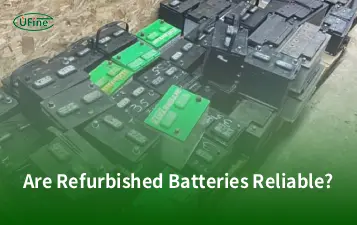
Are Refurbished Batteries Safe and Reliable Today?
Explore the reliability of refurbished batteries with expert insights on testing, cycle life, performance, and key factors affecting longevity.
How to Convert M6/M8 Lithium Battery Terminals to Standard Post Terminals?
Convert M6/M8 lithium battery terminals to standard SAE posts safely. Learn required adapters, installation tips, and ensure stable, reliable conductivity.
Which LiPo Charger Balancer Is Best for Your Battery?
Understand why balancing is essential for multi-cell LiPo charging. Prevent swelling, extend lifespan, and choose the right LiPo balancer.
Can You Replace a 7.2v Nimh Battery and Charger with a Lithium System?
Upgrade 7.2V NiMH to lithium? Learn risks, safety checks, runtime gains, charging changes, and when the upgrade makes financial sense for RC, tools, devices.
Which Bike Battery is Best for a 250W Commuter E-Bike?
Learn how to choose the best battery for your 250W commuter e-bike. Compare sizes, chemistry, and performance for optimal daily use.
